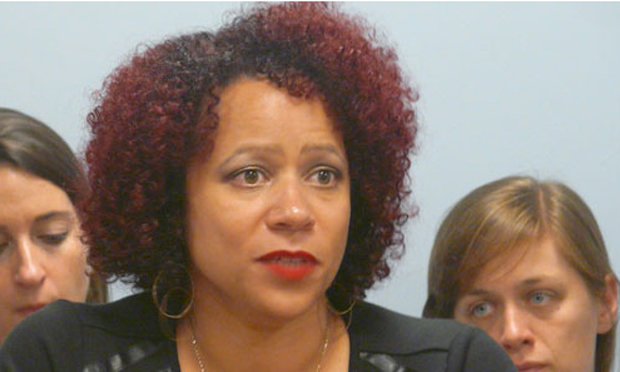
Journalist Nikole Hannah-Jones, who won national recognition in 2015 for her work at ProPublica exploring segregation in America’s schools, offered important insights on how she approaches and investigates issues of racial injustice during a talk she gave at Harvard’s Shorenstein Center on Media, Politics and Public Policy. She also shared her thoughts on newsroom diversity and the media’s broader coverage of racial issues.
Rather than reporting on the “racist of the week” — simply pointing out that a disparity exists, or covering a breaking news incident — Hannah-Jones said her work takes a deeper dive than most reporting, investigating how “inequality is explicitly and intentionally maintained through social policy.” “Instead of writing a story that says ‘housing is segregated’ you go to a community and you show how it got to be segregated … these officials voted to do this thing, or the federal government decided it would not enforce the Fair Housing Act,” said Hannah-Jones, now a staff writer for The New York Times Magazine.
Investigative reporting on racial issues is rare, she said, because of “discomfort with race” and a reluctance to call out people, policies, or institutions as racist. Reporters are also expected to provide evidence of an explicitly racist motive, despite the fact that such motives are seldom requested for other types of reporting, she said. “If Exxon Mobil has a leak in the Gulf, we don’t care whether the CEO of Exxon Mobil hates ducks … could they have prevented it? Did they do things or not do things that led to this?” In the same vein, Hannah-Jones described how she was able to shed light on school re-segregation in Tuscaloosa, Alabama. “They created a feeder line of schools that were 100% Black, and then they deprived those schools of the same resources. The intention was irrelevant.”
After decades of shrinking “race beat” coverage, news outlets are dedicating more resources to coverage of racial issues, which Hannah-Jones said can be a good development. “This is the central thorn in the side of our democracy. Race is not something we should only write about once in a while or when a community explodes — and our lack of doing that means our coverage is actually very shallow and we’re not able to understand why things happen.” She noted that in media coverage of the 2015 Baltimore protests, there was no mention of Baltimore County having recently settled a fair housing lawsuit with the federal government, in which both the local and federal government had been accused of colluding to segregate housing. “That was such a huge backdrop to what happened in Baltimore but no one knew about it, and no one reported about it, because we don’t really do deep reporting on race the way that we do on other subjects.”
Part of the problem can be attributed to newsroom diversity. Although reporters and editors commonly like to think that “anybody should be able to write about these issues,” without a newsroom that is more reflective of the U.S. population, “you miss out on access to communities,” said Hannah-Jones.
Diversity, or lack of it, also influences what stories get written. The fact that the information contained in the Department of Justice’s report on Ferguson “had to come out of the Justice Department and a small civil rights group, as opposed to the newspapers and the other media down there is very telling,” said Hannah-Jones. Lack of newsroom diversity also results in some communities being overlooked entirely, such as Asians and Native Americans, while stories about Latino communities focus predominantly on immigration, she said.
Hannah-Jones discussed the challenges of surfacing controversial topics for a mainstream audience. “Race is very, very hard for Americans. We want to believe that we are fundamentally a fair society, and that everyone who works hard can get the same things, and that I got everything that I deserved. And my work is largely saying that is not true — that is very hard for people to swallow.” While writing, she tries to anticipate the questions or objections a reader could have, and she provides extensive historical background on the situation.
Segregation “hides away all of this ugliness and all of this pain from the people who have the ability to do something about it, because they never have to actually see it. And so they don’t have to believe that it’s actually that bad,” said Hannah-Jones. “My role is to expose these things to people who can and should do something about it.”
Hannah-Jones also discussed the creation of and reaction to her recent “This American Life” story, the role of the media in the Civil Rights Movement, objectivity and emotional expression in journalism, and the intersection of class and race in school segregation. Listen to the full audio recording above.
